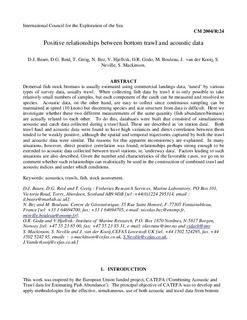| dc.description.abstract | Demersal fish stock biomass is usually estimated using commercial landings data, ‘tuned’ by various types of survey data, usually trawl. When collecting fish data by trawl it is only possible to take relatively small numbers of samples, but each component of the catch can be measured and resolved to species. Acoustic data, on the other hand, are easy to collect since continuous sampling can be maintained at speed (10 knots) but discerning species and size structure from data is difficult. Here we investigate whether these two different measurements of the same quantity (fish abundance/biomass) are actually related to each other. To do this, databases were built that consisted of simultaneous acoustic and catch data collected during a trawl haul. These are described as 'on station data'. Both trawl haul and acoustic data were found to have high variances and direct correlation between them tended to be weakly positive, although the spatial and temporal trajectories captured by both the trawl and acoustic data were similar. The reasons for this apparent inconsistency are explained. In many situations, however, direct positive correlation was found; relationships perhaps strong enough to be extended to acoustic data collected between trawl stations, ie. 'underway data'. Factors leading to such situations are also described. Given the number and characteristics of the favorable cases, we go on to comment whether such relationships can realistically be used in the construction of combined trawl and acoustic indices and under which conditions. | en |
